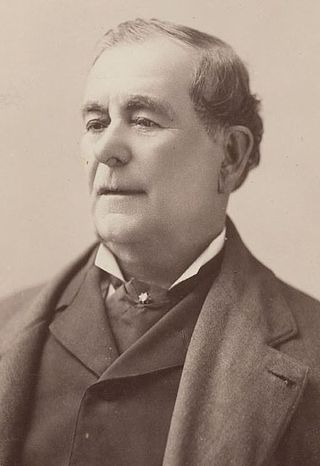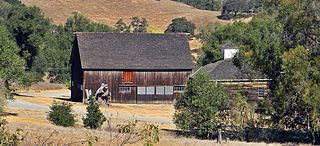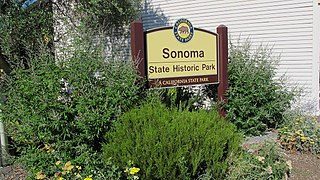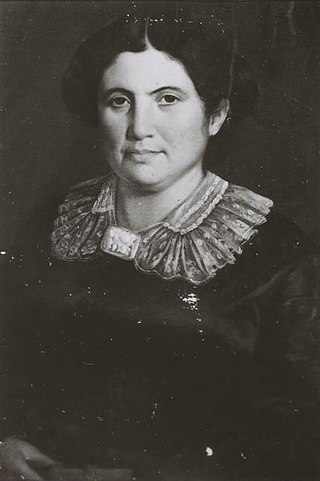
Mission San Francisco Solano was the 21st, last, and northernmost mission in Alta California. It was named for Saint Francis Solanus. It was the only mission built in Alta California after Mexico gained independence from Spain. The difficulty of its beginning demonstrates the confusion resulting from that change in governance. The California Governor wanted a robust Mexican presence north of the San Francisco Bay to keep the Russians who had established Fort Ross on the Pacific coast from moving further inland. A young Franciscan friar from Mission San Francisco de Asis wanted to move to a location with a better climate and access to a larger number of potential converts.

Don Mariano Guadalupe Vallejo was a Californio general, statesman, and public figure. He was born a subject of Spain, performed his military duties as an officer of the Republic of Mexico, and shaped the transition of Alta California from a territory of Mexico to the U.S. state of California. He served in the first session of the California State Senate. The city of Vallejo, California, is named after him, and the nearby city of Benicia is named after his wife.

Sonoma Valley is a valley located in southeastern Sonoma County, California, in the North Bay region of the San Francisco Bay Area. Known as the birthplace of the California wine industry, the valley is home to some of the earliest vineyards and wineries in the state, some of which survived the phylloxera epidemic of the 1870s and the impact of prohibition in the early 20th century. Today, the valley's wines are promoted by the U.S. federal government's Sonoma Valley and Carneros AVAs.

Rancho Petaluma Adobe is a historic ranch house in Sonoma County, California. It was built from adobe bricks in 1836 by order of Mariano Guadalupe Vallejo. It was the largest privately owned adobe structure built in California and is the largest example of the Monterey Colonial style of architecture in the United States. A section of the former ranch has been preserved by the Petaluma Adobe State Historic Park and it is both a California Historic Landmark and a National Historic Landmark. The Rancho Petaluma Adobe State Historic Park is located on Adobe Road on the east side of the present-day town of Petaluma, California.

Olompali State Historic Park is a 700-acre (2.8 km2) California State Park in Marin County, California. It is constituted of the former Rancho Olómpali and was the site of the famed Battle of Olómpali during the Bear Flag Revolt. Rancho Olómpali was purchased by the Californian government in 1977, which turned it into a public park.

Sonoma State Historic Park is a California State Park located in the center of Sonoma, California. The park consists of six sites: the Mission San Francisco Solano, the Sonoma Barracks, the Blue Wing Inn, La Casa Grande, Lachryma Montis, and the Toscano Hotel.

The José Castro House, sometimes known as the Castro-Breen Adobe, is a historic adobe home in San Juan Bautista, California, facing the Plaza de San Juan. The Monterey Colonial style house was built 1838-41 by General José Antonio Castro, a former Governor of Alta California. It was later sold to the Breen family, who lived there until 1933, when the house became a museum as part of San Juan Bautista State Historic Park.

Sonoma Plaza is the central plaza of Sonoma, California. The plaza, the largest in California, was laid out in 1835 by Mariano Guadalupe Vallejo, founder of Sonoma.

The Vallejo Estate is a historic house in Sonoma, California, one of the six sites that comprises the Sonoma State Historic Park. The estate was owned by General Mariano Guadalupe Vallejo, a Californio military leader and landowner. Vallejo began buying the acreage for the house after returning from the California constitutional convention in Monterey in 1849, and resided in the house from 1852 until his death in 1890. He named the house Lachryma Montis, a rough Latin translation of Chiucuyem – the Native American name for the free-flowing spring on the property.

Agua Mansa is a former settlement in an unincorporated area of San Bernardino County, near Colton, California, United States. Once the largest settlement in San Bernardino County, it is now a ghost town. Only the cemetery remains.
This is a list of the properties and districts — listed as California Historical Landmarks — within Sonoma County, California.

The Blue Wing Inn in Sonoma, California, was one of the first hotels built in the state north of San Francisco. What began as the first property transfer in the new Pueblo de Sonoma and a simple adobe residence transformed with time and the addition of more rooms into a storied landmark. During the California Gold Rush it was used by miners going to and from the gold fields and by the U.S. Army soldiers stationed in Sonoma. After many years, owners and uses - the Blue Wing Inn was purchased by the State of California in 1968 and is currently under study for its best use as part of Sonoma State Historic Park.

The Sonoma Barracks is a two-story, wide-balconied, adobe building facing the central plaza of the City of Sonoma, California. It was built by order of Mariano Guadalupe Vallejo to house the Mexican soldiers that had been transferred from the Presidio of San Francisco in 1835. The Presidio Company and their commander, Vallejo, were also responsible for controlling the Native Americans living on the northern border of Mexican California.

Doña Francisca Benicia Carrillo de Vallejo (1815-1891) was a Californio pioneer. A member of the Carrillo family of California, Carrillo was the wife of Mariano Guadalupe Vallejo. Carrillo was an early settler of Sonoma, California, the town founded by her husband. She survived the Bear Flag Rebellion and went on to oversee the Vallejo estate, Lachryma Montis, until her death in 1891. The city of Benicia, California is named after her.

The Salvador Vallejo Adobe is a historic building located in Sonoma, California in the United States. The building is a California Historic Landmark.
Stone And Kelsey Home is a historical house in Kelseyville, California in Lake County. The house was built by Charles Stone and Andy Kelsey in 1849. Californios Salvador Vallejo (1813–1876), General Mariano Guadalupe Vallejo younger brother, sold the land to Charles Stone and Andy Kelsey. Charles Stone used forced Pomo tribe Native Americans labor to build their adobe house. Their home was the first adobe house in Lake County. Later the Indians killed both Stone and Kelsey in the fall of 1849, due to the resentment of forced labor and other cruel acts. Pomo tribesmen were also forced to labor in the nearby gold mines, including Kelsey Diggings. Later as reprisal there was the Bloody Island massacre by the U.S. Military. The site of the house is a California Historical Landmark No. 426. There is a Historical marker at the site of Charles Stone and Andy Kelsey Home, they are buried under the Historical marker.
Sebastiani Vineyard and Winery also called the San Francisco Solano de Sonoma Mission Vineyard was founded in 1825 in Sonoma, California in Sonoma County, California. The Sebastiani Vineyard and Winery is a California Historical Landmark No. 739 listed on June 6, 1960. Sebastiani Vineyard and Winery was founded by the Franciscan Fathers at the Mission San Francisco Solano. The wine produced was used for Holy communion in worship church services and Holy mass. The San Francisco Solano de Sonoma Mission Vineyard was the first vineyard in Sonoma Valley. All the California Missions lost land and building in the Mexican secularization act of 1833. First Mexican Republic sold the San Francisco Solano de Sonoma Mission Vineyard to Samuele Sebastiani in 1902. Sebastiani was a young immigrant from Italy who ran the Sebastiani Vineyard and Winery with his wife Elvira. The Sebastiani Vineyard and Winery continues to be a Sebastiani family runs vineyard and winery at 394 4th Street in Sonoma.

Temelec Hall is historical building built in 1858, in Sonoma, California in Sonoma County, California. The Temelec Hall is a California Historical Landmark No. 496 listed on June 10, 1936. Temelec Hall is also a National Register of Historic Places April 19, 2006. Temelec Hall was built by Captain Granville P. Swift (1821-1875), a member of the Bear Flag Party and took part in the short Mexican–American War in 1846–1848. Swift was the great-grandnephew to Daniel Boone. Swift found gold in 1949 California Gold Rush. With the gold, Swift built the building with stone quarried here by native labor. General Persifor Frazer Smith, a United States Army commander in lived in a small house near Temelec Hall in 1849. After Swift Temelec Hall was sold a few times. In 1915 it was sold to the Coblentz family, who restored the run down building. Coblentz family sold the Hall and it lands in 1961, to a developer. The developer built the Temelec retirement community with the Hall as historical centerpiece.

Union Hotel and Union Hall Site is historical site of buildings built in 1850, in Sonoma, California in Sonoma County, California. The Union Hotel and Union Hall Site is a California Historical Landmark No. 627 listed on January 13, 1958. The original Union Hotel was a one-story adobe built by three veterans of the Mexican–American War. Next to the Union Hotel was built the Union Hall. The two buildings were lost in 1866 fire. The Union Hotel was rebuilt into a two-story stone hotel. The Hotel was on the second floor and a hall was on the first floor. The Union Hotel and Union Hall were on the south side of the Sonoma Plaza.

Walters Ranch Hop Kiln is historical site of buildings built in 1905, in Sonoma, California in Sonoma County, California. The Walters Ranch Hop Kiln is a California Historical Landmark No. 627 listed on January 13, 1958. The Walters Ranch Hop Kiln was built by Italian stonemason, Angelo "'Skinny" Soldini. Sol Walters purchased 380 acres of the Rancho Sotoyome, a 1853 Mexican land grant to Josefa Fitch. The Walters Ranch Hop Kiln is composed of three stone kilns for drying hops for 20 hours a patch. Hops are used in beer making breweries. In addition to the kilns, the site as a wooden building for cooling the hops and a two-story press for baling the hops for shipment. The Walters Ranch Hop Kilns was one of early and large operation in the Northern California region.

























